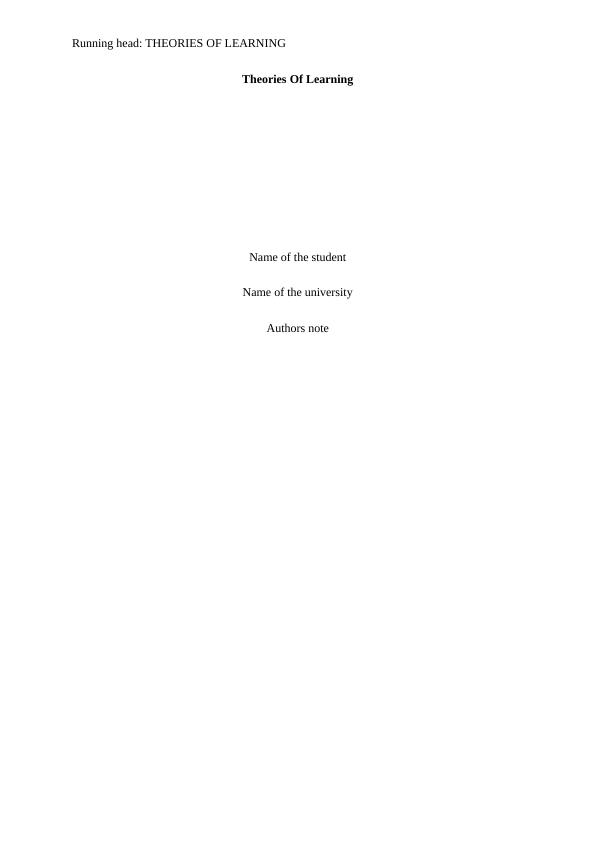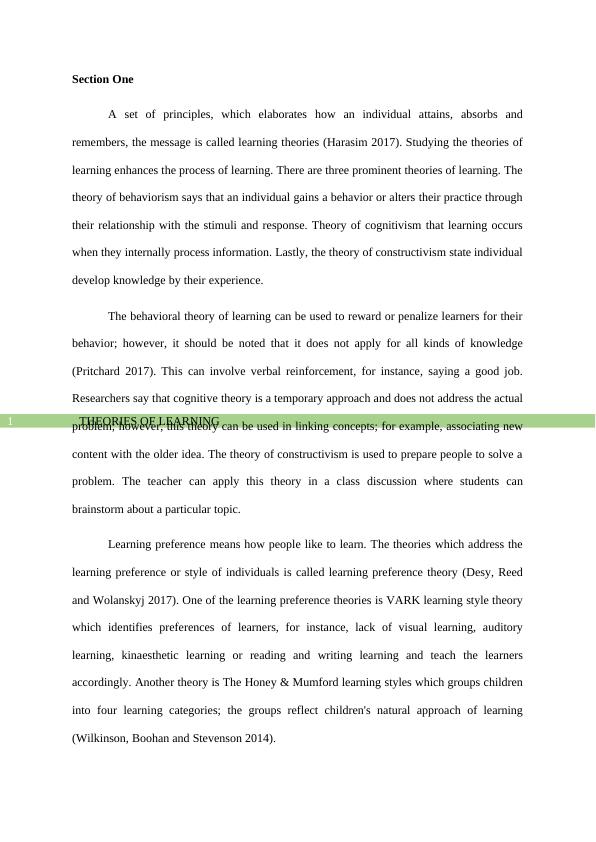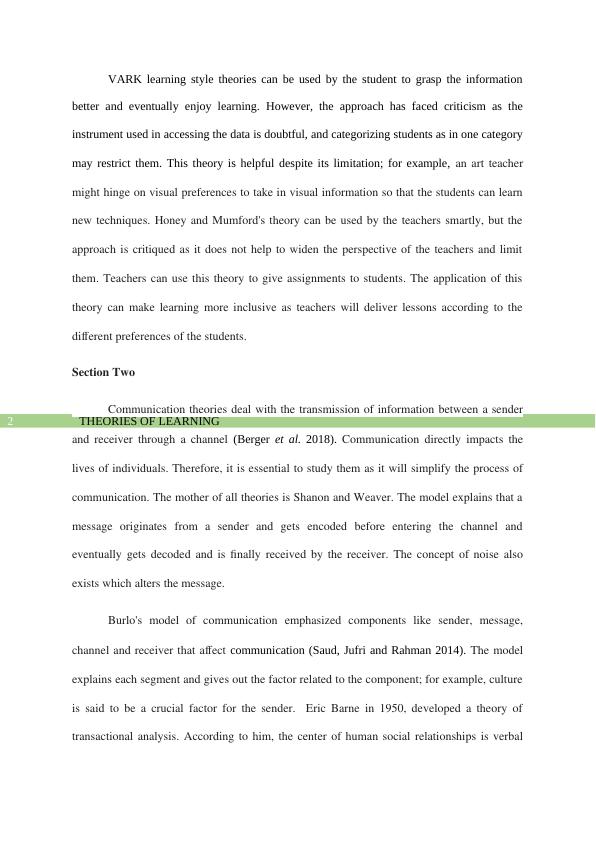The Theory of Behaviorism PDF
10 Pages2928 Words32 Views
Added on 2022-08-14
The Theory of Behaviorism PDF
Added on 2022-08-14
ShareRelated Documents
Running head: THEORIES OF LEARNING
Theories Of Learning
Name of the student
Name of the university
Authors note
Theories Of Learning
Name of the student
Name of the university
Authors note

THEORIES OF LEARNING1
Section One
A set of principles, which elaborates how an individual attains, absorbs and
remembers, the message is called learning theories (Harasim 2017). Studying the theories of
learning enhances the process of learning. There are three prominent theories of learning. The
theory of behaviorism says that an individual gains a behavior or alters their practice through
their relationship with the stimuli and response. Theory of cognitivism that learning occurs
when they internally process information. Lastly, the theory of constructivism state individual
develop knowledge by their experience.
The behavioral theory of learning can be used to reward or penalize learners for their
behavior; however, it should be noted that it does not apply for all kinds of knowledge
(Pritchard 2017). This can involve verbal reinforcement, for instance, saying a good job.
Researchers say that cognitive theory is a temporary approach and does not address the actual
problem; however, this theory can be used in linking concepts; for example, associating new
content with the older idea. The theory of constructivism is used to prepare people to solve a
problem. The teacher can apply this theory in a class discussion where students can
brainstorm about a particular topic.
Learning preference means how people like to learn. The theories which address the
learning preference or style of individuals is called learning preference theory (Desy, Reed
and Wolanskyj 2017). One of the learning preference theories is VARK learning style theory
which identifies preferences of learners, for instance, lack of visual learning, auditory
learning, kinaesthetic learning or reading and writing learning and teach the learners
accordingly. Another theory is The Honey & Mumford learning styles which groups children
into four learning categories; the groups reflect children's natural approach of learning
(Wilkinson, Boohan and Stevenson 2014).
Section One
A set of principles, which elaborates how an individual attains, absorbs and
remembers, the message is called learning theories (Harasim 2017). Studying the theories of
learning enhances the process of learning. There are three prominent theories of learning. The
theory of behaviorism says that an individual gains a behavior or alters their practice through
their relationship with the stimuli and response. Theory of cognitivism that learning occurs
when they internally process information. Lastly, the theory of constructivism state individual
develop knowledge by their experience.
The behavioral theory of learning can be used to reward or penalize learners for their
behavior; however, it should be noted that it does not apply for all kinds of knowledge
(Pritchard 2017). This can involve verbal reinforcement, for instance, saying a good job.
Researchers say that cognitive theory is a temporary approach and does not address the actual
problem; however, this theory can be used in linking concepts; for example, associating new
content with the older idea. The theory of constructivism is used to prepare people to solve a
problem. The teacher can apply this theory in a class discussion where students can
brainstorm about a particular topic.
Learning preference means how people like to learn. The theories which address the
learning preference or style of individuals is called learning preference theory (Desy, Reed
and Wolanskyj 2017). One of the learning preference theories is VARK learning style theory
which identifies preferences of learners, for instance, lack of visual learning, auditory
learning, kinaesthetic learning or reading and writing learning and teach the learners
accordingly. Another theory is The Honey & Mumford learning styles which groups children
into four learning categories; the groups reflect children's natural approach of learning
(Wilkinson, Boohan and Stevenson 2014).

THEORIES OF LEARNING2
VARK learning style theories can be used by the student to grasp the information
better and eventually enjoy learning. However, the approach has faced criticism as the
instrument used in accessing the data is doubtful, and categorizing students as in one category
may restrict them. This theory is helpful despite its limitation; for example, an art teacher
might hinge on visual preferences to take in visual information so that the students can learn
new techniques. Honey and Mumford's theory can be used by the teachers smartly, but the
approach is critiqued as it does not help to widen the perspective of the teachers and limit
them. Teachers can use this theory to give assignments to students. The application of this
theory can make learning more inclusive as teachers will deliver lessons according to the
different preferences of the students.
Section Two
Communication theories deal with the transmission of information between a sender
and receiver through a channel (Berger et al. 2018). Communication directly impacts the
lives of individuals. Therefore, it is essential to study them as it will simplify the process of
communication. The mother of all theories is Shanon and Weaver. The model explains that a
message originates from a sender and gets encoded before entering the channel and
eventually gets decoded and is finally received by the receiver. The concept of noise also
exists which alters the message.
Burlo's model of communication emphasized components like sender, message,
channel and receiver that affect communication (Saud, Jufri and Rahman 2014). The model
explains each segment and gives out the factor related to the component; for example, culture
is said to be a crucial factor for the sender. Eric Barne in 1950, developed a theory of
transactional analysis. According to him, the center of human social relationships is verbal
VARK learning style theories can be used by the student to grasp the information
better and eventually enjoy learning. However, the approach has faced criticism as the
instrument used in accessing the data is doubtful, and categorizing students as in one category
may restrict them. This theory is helpful despite its limitation; for example, an art teacher
might hinge on visual preferences to take in visual information so that the students can learn
new techniques. Honey and Mumford's theory can be used by the teachers smartly, but the
approach is critiqued as it does not help to widen the perspective of the teachers and limit
them. Teachers can use this theory to give assignments to students. The application of this
theory can make learning more inclusive as teachers will deliver lessons according to the
different preferences of the students.
Section Two
Communication theories deal with the transmission of information between a sender
and receiver through a channel (Berger et al. 2018). Communication directly impacts the
lives of individuals. Therefore, it is essential to study them as it will simplify the process of
communication. The mother of all theories is Shanon and Weaver. The model explains that a
message originates from a sender and gets encoded before entering the channel and
eventually gets decoded and is finally received by the receiver. The concept of noise also
exists which alters the message.
Burlo's model of communication emphasized components like sender, message,
channel and receiver that affect communication (Saud, Jufri and Rahman 2014). The model
explains each segment and gives out the factor related to the component; for example, culture
is said to be a crucial factor for the sender. Eric Barne in 1950, developed a theory of
transactional analysis. According to him, the center of human social relationships is verbal

End of preview
Want to access all the pages? Upload your documents or become a member.
Related Documents
Theories, Principles and Models in Education and Traininglg...
|5
|787
|79
Theories Principles and Models in Education and Traininglg...
|14
|3073
|453
Report on PPD plan and Self-learning Styleslg...
|17
|4026
|28
Learning Techniques: Importance in Education and Healthcare Promotionlg...
|5
|1144
|400
Importance and Criticism of VARK Model for Study Skills in Higher Educationlg...
|6
|1973
|414
Study Skills for Higher Educationlg...
|8
|2201
|1
